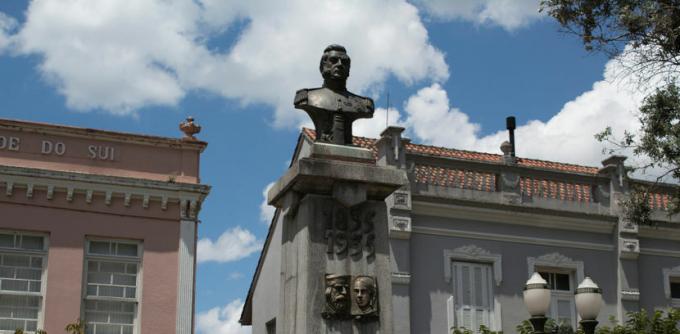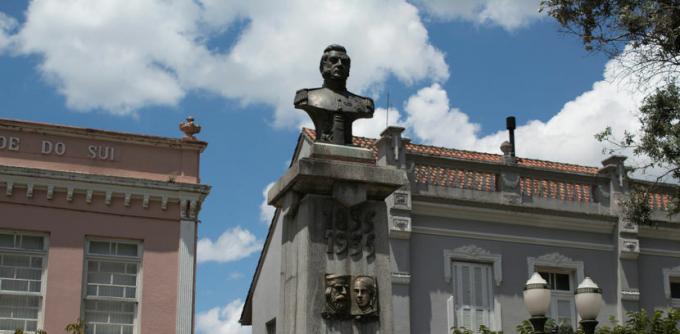THE warsrags, also known as RevolutionRagamuffin, was a separatist revolt started in Rio Grande do Sul (1835 to 1845), during the Governing Period. It mobilized the ranching elite that lived in the interior of the state and its main cause was the elite's dissatisfaction with the lack of autonomy and the heavy taxes levied, especially on jerky (dry meat).
This revolt, which had names like Bento Gonçalves and David Canabarro, was the biggest provincial revolt of the entire Brazilian monarchic period, as it lasted 10 years. The Farrapos were defeated, in large part by the action of Barão de Caxias, one of the great names of the Brazilian Army in the 19th century.
Accessalso: Coup of age: the maneuver that ended the Regency Period
Historical context of the Farrapos War
Rio Grande do Sul was a province that had a large amount of ranchers and charqueadores, which raised cattle and produced jerky, respectively. These two economic activities were established in this region, at the turn of the 17th and 18th centuries, to meet the needs of the Brazilian Center-South – jerky, for example, was used in food From slaves.

Another important point to be mentioned was the relative autonomy of Rio Grande do Sul for being distant from Rio de Janeiro, then capital of Brazil. In addition, the work of the troops of the ranchers to ensure the defense of their lands is also noteworthy, given the numerous territorial conflicts in the region, first between the Portuguese and the Spanish and then between Brazilians, Uruguayans and Argentines.
The autonomy of ranchers in Rio Grande do Sul began to decline with the independence of Brazil, and the centralizing project imposed by d. Pedro I, of course, displeased the gauchos. In addition to this issue, we must consider issues relating to economic factors, especially the taxes that were levied on ranchers and charqueadores.
There was great dissatisfaction with the amount of taxes on beef jerky produced in Rio Grande do Sul. In addition, the gauchos wanted foreign jerky to be taxed to make competition between goods fairer.
In addition to these demands, they wanted the end of an existing tax on cattle that circulated on the border between Brazil and Uruguay, in addition to being dissatisfied with the presence of national troops in the region - a consequence gives Cisplatin War. Many also disliked the creation of the National Guard, by an 1831 law.
Journalist Juremir Machado mentioned that even one tick crisis that affected the ranchers' cattle in 1834, was a reason to increase the Gauchos' dissatisfaction with the government, since it refused to bear the losses of the Gaucho producers|1|. Within this scenario of dissatisfaction, the possibility of revolt began to gain strength around republican and federalist ideals.
Mainevents in the Farrapos War
great leaders of rags (Gauchos who fought in the Farrapos War) met on September 18, 1835, and decided that the revolt would start two days later (September 20). When the uprising started, it had no separatist character, but the course of events led it down the path of separatism. Early on, the Farrapos sent troops to Porto Alegre and conquered the state capital without encountering resistance.
It was only on September 11, 1836 that the Farrapos decided to separate and the Republic of Piratini or Rio Grande Republic. This started a new phase of the revolution, and conflicts became more aggressive. The declaration of independence carried out by the gauchos was motivated by their victory in the Battle of Seival, held on September 10th.
Many historians claim that the proclamation of the Rio-Grandense Republic ended the “revolt” phase and marked the beginning of the “war” phase. benedictGonçalves, one of the leaders of the Farrapos, was appointed president of that republic in 1836, but only managed to take office in the following year, after escaping from prison in 1837.

In the first years of the revolution, the Farrapos managed to overcome the imperial forces and won important battles, such as the Battle of Seival and the Battle of Barro Vermelho. OneA defining moment came in July 1839, when David Canabarro and Giuseppe Garibaldi led the conquest of Laguna and founded the Julian Republic, located in the current state of Santa Catarina.
Control over the Laguna region, however, was short-lived, as in November 1839 the imperial troops had already reconquered the region. The fall of Laguna also marked the beginning of the decay of the Farrapos in the struggle against the Empire. Some factors that contributed to the defeat of the Farrapos were:
Other provincial revolts, such as the sabinada, a cabin and the Balaiada, closed between 1840 and 1841. This allowed the Empire to concentrate its forces against the gauchos.
Appointment of Luís Alves de Lima e Silva – at the time, Barão de Caxias – to lead the imperial troops.
The weakening of the Farrapos was evident, because from 1842 onwards, the fighting (which was no longer great) took on an air of guerrilla war. The Farrapos no longer faced the imperial troops and many began to take refuge in Uruguay. In addition, there was also a division between the Farroupilha leaders. Bento Gonçalves and Onofre Pires, for example, ended up dueling after a disagreement.
Leaders of the Farrapos War
Among the leaders of the Farroupilha Revolution, the following names can be highlighted:
benedictGonçalves: son of rich farmers, he was a military man and one of the leaders of the revolution, being named president of the Republic of Rio Grande.
DavidCanabarro: military man who played an important role in leading Farrapos troops and was one of those who proclaimed the Julian Republic in 1840.
GiuseppeGaribaldi: Italian known for his involvement with revolutions here in Brazil and also in Europe. He joined with Canabarro in the conquest of Laguna and the proclamation of the Julian Republic.
Antônio de Souza Neto: great military leader of the Farrapos who was involved in the Battle of Seival in 1836. He participated directly in the proclamation of the Rio-Grandense Republic, in 1836.
Accessalso: Malês Revolt - biggest slave revolt in Brazilian history
Outcome of the Farrapos War
As mentioned, the Farrapos began to weaken from 1840 onwards due to the end of other provincial revolts and the appointment of the Baron of Caxias as commander of the imperial troops. the baron, through military tactics and diplomacy, managed to expand the weakening of the rags, forcing them to negotiate.
Negotiations between Farrapos and the Empire resulted in the Green Poncho Treaty, signed on March 1, 1845, which determined the following:
Farrapos would have the right to nominate their own provincial president (governor);
All rebels would be pardoned, that is, forgiven;
The debts incurred by the rags after ten years of conflict would be paid by the government;
The slaves who fought for the Farrapos would be freed;
The military officers of the Farrapos would be part of the Imperial Army and would maintain the same rank;
Foreign jerky would be taxed at 25%.
Accessalso: Paraguay War - the conflict that weakened the Empire
War of the Farrapos and slavery
The Farrapos War is identified by historians as an event that is the target of profound myth in the state of Rio Grande do Sul. One of the subjects on which mythification takes place is the issue related to slavery. Many spread the idea that the Farrapos were also fighting for the freedom of black slaves, but historians say otherwise.
Defenders of the Farrapos usually point to the Poncho Verde Treaty as a demonstration that the gauchos were fighting for the end of slavery. Article 4 of this treaty contains the following determination: “all captives who served the Republic are free, and recognized as such”. The phrase suggests that the agreement between the gauchos and the government was freedom for all blacks who fought in defense of the rags.
Historians, however, have shown that the abolition of slavery was never a priority. of the rags. During the years in which the revolt/war was ongoing, the Farrapos kept their slaves and only freed blacks who agreed to join the military forces to fight the Empire. Even the financing of arms for the Farrapos took place through the sale of slaves in Uruguay.
One of the leaders of the Farrapos, Bento Gonçalves, kept dozens of slaves in his possession throughout his life and left them as an inheritance for his family. Finally, a symptomatic case regarding the questionable treatment that the Farrapos dedicated to blacks concerns the case ofBattle of Porongos, when the Black Lancer troops were disarmed and delivered in a snare so that the imperial troops could massacre the soldiers.
This event happened because, according to Juremir Machado, the Farroupilha leaders would not be able to keep their promise of freedom for the blacks who formed this troop, as the Empire had not agreed to free blacks who had fled from other states and joined the troops rags. Thus, the solution found by the leaders was to disarm and hand over the location of this troop so that they could be massacred.
Grades
|1| Juremir: “many commemorate the Revolution without knowing the history”. To access, click on here.
Take the opportunity to check out our video classes related to the subject:


